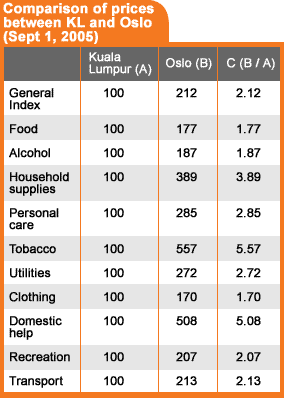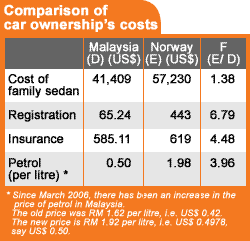Recently, an English daily published figures to justify the above statement. We contend that KL is indeed relatively cheap - but only for foreigners in the 82 countries with per capita income (PCI) higher than ours. It won't be cheap for the large number of countries with lower PCI with the ranking of 84 and below, say, Thailand with ranking 97.
With our miserable income, there is nothing for Malaysians to be happy about. The foreigners from these 82 countries can visit Malaysia and enjoy themselves but very unfortunately we Malaysians cannot do the same in their countries since our ringgit so weak compared to their currencies.
 Anyway, let us see how cheap KL really is compared to Oslo and how happy we should be with our ranking, given the purchasing power of the ringgit.
Anyway, let us see how cheap KL really is compared to Oslo and how happy we should be with our ranking, given the purchasing power of the ringgit.
The PCI 2005 for Malaysia is US$10,400 but for Norway it is US$42,400. We can surmise that a Norwegian earns, on average, 4.1 times more than a Malaysian. Let us now look at the table published.
Column C shows how many times a Norwegian has to pay for a particular product or service compared to a Malaysian, but bear in mind that he earns 4.1 times more than a Malaysian. With the exception of tobacco and domestic help, which many of us can do without, we feel that the average Norwegian is far better off than an average Malaysian. The figures in column C speak for themselves.
 As for car ownership, the cost of the car is the greatest financial burden to the purchaser. Although the Norwegian pays 38% more for a car, he earns 4.1 times or 310 % more than the Malaysian. In the case of car registration and insurance, these are a one-off payment for the duration of the car ownership; say five years or even longer. We concede that petrol is comparatively cheaper in Malaysia, but then Malaysia is a net exporter of oil. And any oil price increase should actually be an added benefit to Malaysia. Therefore, when the world's oil price increases, our domestic pump price should go down. But that does not seem to be the case.
As for car ownership, the cost of the car is the greatest financial burden to the purchaser. Although the Norwegian pays 38% more for a car, he earns 4.1 times or 310 % more than the Malaysian. In the case of car registration and insurance, these are a one-off payment for the duration of the car ownership; say five years or even longer. We concede that petrol is comparatively cheaper in Malaysia, but then Malaysia is a net exporter of oil. And any oil price increase should actually be an added benefit to Malaysia. Therefore, when the world's oil price increases, our domestic pump price should go down. But that does not seem to be the case.
Let us now look at the case for compact discs, CDs. If a Malaysian has US$100, he can buy 8.3 (US$100/ US$12.035) CDs. However, a Norwegian earns 4.1 times more than a Malaysian and so has UD$410 to spend. Although the CDs cost twice as much (2 x US$12.035 = US$ 24.07), he can buy 17 (US$410/US$24.07) CDs. This means that as far as CDs are concerned, his purchasing power is 2.05 (17/8.3) is more than twice ours.
We do not have the spread for the national monthly income for both Malaysia and Norway but in Malaysia if we were to sample 100 persons, how many would actually earn more than RM3,293 (US$10,400 x 3.7/12) per month? Of course, if the sample comes from Damansara Heights, Northam Road in Penang, Tropicana or Kenny Hills, many actually do earn this or even many times more than this amount. But then, how many housing estates in Malaysia are like those mentioned? What do these figures say about the spread of national income? Therefore, should we really be happy with this ranking?
Of course, we have a higher percentage of middle-class people compared to Philippines, Burma, Indonesia. For that, we suppose, we should be grateful!
Note: Since March 2006, there has been an increase in the price of petrol in Malaysia. The old price was RM1.62 per litre, ie, US$ 0.42 .The new price is RM1.92 per litre, ie US$ 0.4978 , say US$0.50.

